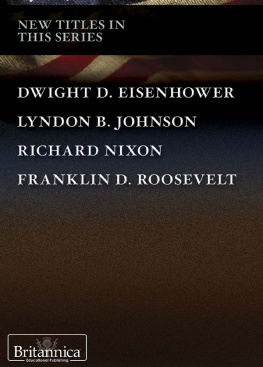

Published in 2017 by Britannica Educational Publishing (a trademark of Encyclopdia Britannica, Inc.) in association with The Rosen Publishing Group, Inc.
29 East 21st Street, New York, NY 10010
Copyright 2017 by Encyclopdia Britannica, Inc. Britannica, Encyclopdia Britannica, and the Thistle logo are registered trademarks of Encyclopdia Britannica, Inc. All rights reserved.
Rosen Publishing materials copyright 2017 The Rosen Publishing Group, Inc. All rights reserved.
Distributed exclusively by Rosen Publishing.
To see additional Britannica Educational Publishing titles, go to rosenpublishing.com.
First Edition
Britannica Educational Publishing
J.E. Luebering: Executive Director, Core Editorial
Anthony L. Green: Editor, Comptons by Britannica
Rosen Publishing
Meredith Day: Editor
Nelson S: Art Director
Ellina Litmanovich: Designer
Cindy Reiman: Photography Manager
Bruce Donnolla: Photo Researcher
Library of Congress Cataloging-in-Publication Data
Names: Day, Meredith, editor.
Title: Lyndon B. Johnson / edited by Meredith Day.
Description: First edition. | New York : Britannica Educational Publishing in association with Rosen Educational Services, 2017. | Series: Pivotal presidents: profiles in leadership | Includes bibliographical references and index. | Audience: Grades 7-12.
Identifiers: LCCN 2015050688 | ISBN 9781680485158 (eBook)
Subjects: LCSH: Johnson, Lyndon B. (Lyndon Baines), 1908-1973. | Presidents--United StatesBiography. | United States--Politics and government--1963-1969.
Classification: LCC E847 .L964 2016 | DDC 973.923092--dc23
LC record available at http://lccn.loc.gov/2015050688
Photo credits: Cover, Francis Miller/The LIFE Picture Collection/Getty Images; interior pages flag Fedorov Oleksiy/Shutterstock.com.
Table of Contents


Jacqueline Kennedy(right)and Lady Bird Johnson stand by Lyndon B. Johnson as he takes the oath of office aboard Air Force One after the assassination of President John F. Kennedy on November 22, 1963.
At 2:38 PM, on November 22, 1963, Lyndon B. Johnson took the oath of office as the 36th president of the United States. On his right stood his wife, Lady Bird. On his left stood Jacqueline Kennedy, stony-faced with shock. Less than two hours earlier, President John F. Kennedy had died in a Dallas hospital from an assassins bullets. He had been shot while riding in a motorcade through downtown Dallas. Johnson, riding two cars behind Kennedy, was unhurt.
As vice president of the United States, Lyndon Johnson immediately became president. He was the fourth vice president to be thrust into the nations top office by the assassination of his predecessor. The new presidents first message to the nation, televised the evening of that fateful day on his arrival at Andrews Air Force Base, near Washington, D.C., was brief. I will do my best. That is all I can do. I ask for your help, and Gods.
Johnson immediately went to work passing legislation that had been proposed by the Kennedy Administration. Having been the Senate majority leader before his election as vice president, he was skilled at negotiating with congressmen to achieve desired results. The Civil Rights Act of 1964 was the most important of these measures passed in his first year as president. Johnson, as a Texan, may have seemed to be an unlikely champion of civil rights, given that the Southern states were the most likely to institutionalize racial discrimination. However, as a young man, Johnson had taught impoverished Mexican American children, and this experience partly inspired his commitment to antipoverty and civil rights programs.
On November 3, 1964, the voters of the nation elected Johnson to a full term. He overwhelmingly defeated Republican Senator Barry M. Goldwater of Arizona. Johnson called his landslide victory a tribute to the program that was begun by our beloved president, John F. Kennedy.
Johnson referred to his administrations programs as the Great Society, by which he aimed to improve life for Americans of all races and economic backgrounds. Other landmark legislation enacted during his presidency included the Voting Rights Act, the Immigration and Nationality Act, and an amendment to the Social Security Act that established Medicare and Medicaid. Unfortunately, the Vietnam War would eventually overshadow his domestic agenda.
After the bombing of a U.S. ship in the Gulf of Tonkin in 1964, Johnson greatly expanded the U.S. role in Vietnam. However, the North Vietnamese found success with their guerrilla tactics. Johnson sent more troops in hopes of turning the tide of the war, but this escalation was extremely costlynot only in dollars, but also in American lives and public support. As antiwar protests grew, so did dissatisfaction among poor African Americans who felt that the promises of the Great Society had gone unfulfilled. Beginning in the mid-1960s, race riots erupted in cities across the country.
On March 31, 1968, the embattled president made a shocking announcement: he would not run for reelection in November. Under the Twenty-second Amendment of the U.S. Constitution, he was eligible to run for a second full term because he had served out fewer than two years of Kennedys term. But the challenges both at home and abroad convinced Johnson that the country needed new leadership. In the same speech, he announced that bombing in North Vietnam would be reduced and that he would seek to begin negotiations to end the war.
Johnsons presidency, begun in tragedy, thus came to an unexpected conclusion. Nevertheless, his administration had led the way on social-welfare reform. Though the war in Vietnam prevented him from reaching the full potential of his program, Johnsons legacy as a champion of civil rights and the rights of ordinary Americans lives on.

L yndon B. Johnson, a six-foot-three-inch Texan, had an air of the frontier even when he was not wearing his ten-gallon hat. Visitors to his LBJ Ranch, near Johnson City, were shown two stone forts built by his grandfather, Samuel Ealy Johnson, founder of Johnson City. They were constructed to protect the first settlers from Indian raids.
His grandfather served in the Texas state legislature and became Texas secretary of state. Legend has it that when he first saw the infant Lyndon, he is said to have prophesied that his grandson would someday be a United States senator.
A SON OF TEXAS PIONEERS
Lyndon Baines Johnson was born on August 27, 1908, on a farm near Stonewall, in the hills of south-central Texas. He was the eldest of five children, including three sisters and a brother, Sam Houston Johnson.


















